Agentic AI vs Generative AI: Which Is Right for Your Business in Singapore? (2025 Guide)
Singapore has rapidly embraced artificial intelligence, with AI adoption among large enterprises rising from 16.7% in 2018 to 44% in 2023, according to IMDA. Among adopters, 96.2% reported improved productivity, 61% reduced costs, and 43.4% saw stronger customer engagement, underscoring AI’s growing role in operational excellence and competitive advantage.
As adoption accelerates across sectors like finance, logistics, and healthcare, a key strategic question is emerging: Should businesses start with generative AI, or move toward the more autonomous capabilities of agentic AI?
This guide explores the key differences between agentic AI vs generative AI, real-world use cases, and decision criteria to help you choose the right approach for your business in Singapore’s fast-evolving AI landscape.
Table of Contents
- What Is Agentic AI?
- What Is Generative AI?
- Agentic AI vs Generative AI: Key Differences
- Real-World Use Cases in Singapore: Who’s Using What?
- How to Choose the Right AI Approach for Your Business
- Why Kaopiz Is a Trusted AI Development Partner in Singapore
- Conclusion
- FAQs
What Is Agentic AI?
Agentic AI refers to artificial intelligence systems that can operate autonomously to achieve specific goals, often without continuous human input.
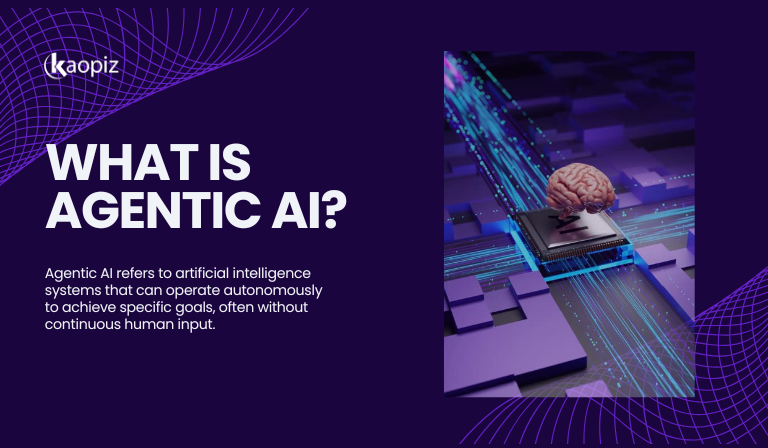
While AI agents broadly refer to systems that perceive and act in an environment (e.g., AI chatbots, recommendation engines), agentic AI represents a more advanced subset. It emphasizes goal-oriented behavior, task decomposition, and multi-step execution, mimicking a form of “digital agency.”
In short:
- AI agent = reactive assistant
- Agentic AI = proactive problem-solver
Key Strengths of Agentic AI:
- Autonomous Decision-Making: Takes initiative, breaks down tasks, and executes them independently.
- Goal-Driven Behavior: Works toward specific outcomes rather than just responding to inputs.
- Adaptability: Learns from data and outcomes to improve over time.
- Workflow Automation: Reduces human workload by managing end-to-end processes.
Common Use Cases of Agentic AI in Business:
- Sales: Automating lead qualification, outreach, and meeting scheduling.
- Customer Support: Handling ticket routing, personalized replies, and proactive service.
- Software Development: Auto-generating and testing code across sprints.
- HR: Automating onboarding workflows and document handling.
- Healthcare: Monitoring patients and recommending care steps in real-time.
Here’s a clear comparison table between agentic AI vs AI agents:
| Criteria | AI Agents | Agentic AI |
|---|---|---|
| Definition | Systems that observe, decide, and act in an environment | Advanced AI agents capable of goal setting, planning, and multi-step execution |
| Level of Autonomy | Reactive or semi-autonomous | Highly autonomous and proactive |
| Goal Orientation | Respond to prompts or rules | Self-directed toward achieving defined goals |
| Task Complexity | Performs single or simple tasks | Decomposes and completes complex, multi-step tasks |
| Learning Capability | May have limited or no learning loop | Continuously improves via feedback and real-world interaction |
| Agency (Self-direction) | Low to moderate | High (can choose actions to meet objectives) |
| Use Cases | Customer support bots, smart assistants | Workflow automation, sales agents, autonomous business processes |
What Is Generative AI?
To better understand the agentic AI definition vs generative AI, it’s essential to look at how each functions. Generative AI (Gen AI) refers to AI models that create new content—such as text, images, audio, or code—based on patterns learned from existing data. Unlike traditional AI that classifies or predicts, gen AI produces original outputs, often mimicking human creativity.
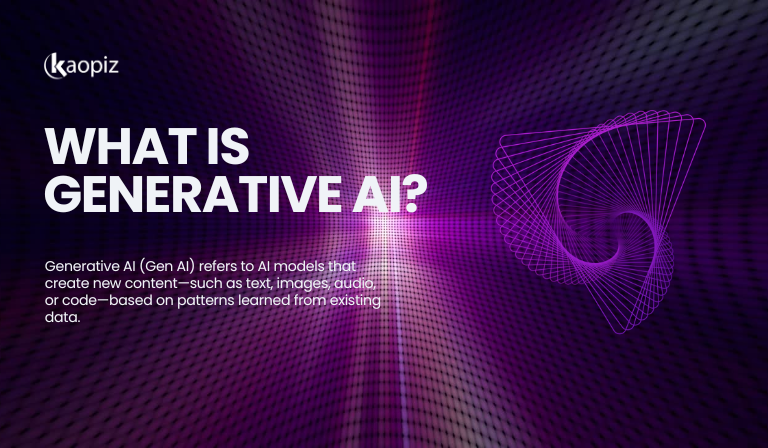
Strengths of Gen AI:
- Content Creation at Scale: Quickly generate high-quality text, images, or videos.
- Personalization: Delivers tailored content and recommendations based on user data.
- Time & Cost Efficiency: Automates repetitive creative tasks like writing, design, and reporting.
Popular Business Applications:
- Marketing: AI-generated emails, social media posts, and ad creatives.
- Customer Support: Chatbots and virtual assistants powered by LLMs.
- Sales Enablement: Auto-generated proposals, pitch decks, and product descriptions.
- Software Development: AI-assisted code generation and documentation.
Agentic AI vs Generative AI: Key Differences
First, let’s explore the key differences between agentic AI vs generative AI at a high level, then break down how they differ in core concepts, functionality, and use cases.
| Aspect | Agentic AI | Generative AI |
|---|---|---|
| Definition | Autonomous AI that plans, decides, and acts toward goals with minimal input | AI that creates new content (text, image, code, etc.) based on training data |
| Primary Purpose | Goal-oriented execution and decision-making | Creative content generation |
| Core Functionality | Multi-step task automation, planning, and real-time action | Pattern recognition and output generation from learned data |
| Technologies Used | Multi-agent systems, LLMs, orchestration tools (e.g., LangChain, AutoGen) | LLMs, GANs, diffusion models |
| Output Type | Actions, decisions, completed workflows | Text, images, audio, video, code |
| Interaction Style | Ongoing, autonomous engagement with context-aware decision-making | One-shot or prompt-based content generation |
| Use Cases | Workflow automation, AI assistants, operations optimization, task chaining | Content creation, chatbots, design generation, summarization |
| Strengths | High autonomy, dynamic adaptability, end-to-end execution | Creativity, scalability, fast content creation |
| Limitations | Complex implementation, requires orchestration and monitoring | Limited to one-step tasks, lacks real-world decision-making capabilities |
Primary Purpose
One of the key ways to distinguish agentic AI vs generative AI is by understanding their primary purpose. Agentic AI is designed for autonomous goal completion. It not only understands tasks but also takes initiative, plans multi-step actions, and adapts behavior to achieve predefined objectives with minimal human intervention.
Gen AI, on the other hand, focuses on creating content—whether it’s text, images, code, or audio—based on patterns learned from large datasets. Its main goal is to generate outputs that mimic human-like creativity and expression.
Core Functionality
Agentic AI is designed for goal-oriented execution. It breaks down complex tasks into smaller steps, makes decisions autonomously, and adapts its actions based on feedback or changing conditions. It doesn’t just generate—it acts, plans, and iterates to achieve defined outcomes.
In contrast, the core functionality of generative AI lies in content generation. It uses patterns learned from vast datasets to produce new outputs—such as text, images, or code—based on a given prompt. Its strength is creative production, but it doesn’t typically manage multi-step processes or adapt after generating output.
Technologies Used
Technologies used are the key factors when comparing generative AI and agentic AI difference. Agentic AI is built on a layered tech stack that extends beyond traditional AI. It typically combines LLMs with orchestration frameworks, multi-agent systems, vector databases, memory components, and reasoning engines. AI Agents Tools like LangChain, AutoGen, and ReAct allow agentic AI to plan, execute, and adapt through dynamic task chains and feedback loops.
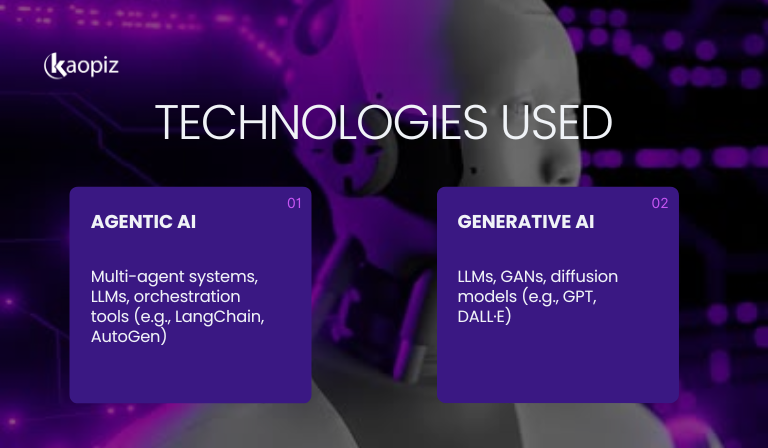
Gen AI primarily relies on transformer-based LLMs and diffusion models trained on vast datasets to generate content. Technologies such as GPT, DALL·E, and Stable Diffusion are optimized for generating human-like text, images, or code, but they typically lack the autonomy or planning capabilities found in agentic AI systems.
Output Type
Agentic AI focuses on goal completion rather than just content generation. Its functional output is typically a sequence of coordinated actions aimed at fulfilling a specific objective, such as booking appointments, automating workflows, or deploying a full software module. The outcome is dynamic, task-driven, and may involve interacting with multiple systems or APIs.
Generative AI, on the other hand, produces static and non-functional outputs like text, images, code snippets, or audio. Its results are usually a single response to a prompt—such as generating a blog post, an image concept, or a chatbot reply—without taking further action beyond that initial creation.
Interaction Style
When considering the interaction style of agentic AI vs generative AI, Agentic AI interacts with a goal-driven and autonomous manner. Once given a task, it can break it down into sub-tasks, make decisions, and take action without further user input. It often collaborates with other agents or systems to complete complex workflows.
In contrast, Gen AI relies on a prompt response model. It responds to individual inputs from the user and does not retain long-term objectives or execute multi-step processes autonomously. Each interaction is typically one-off and guided by the user.
Use Cases
Agentic AI excels in scenarios requiring autonomy, multi-step reasoning, and task execution. It’s ideal for workflow automation, autonomous customer service agents, HR onboarding bots, personalized learning systems, and end-to-end process optimization, where the system can plan, act, and adapt in real-time without constant human prompts.
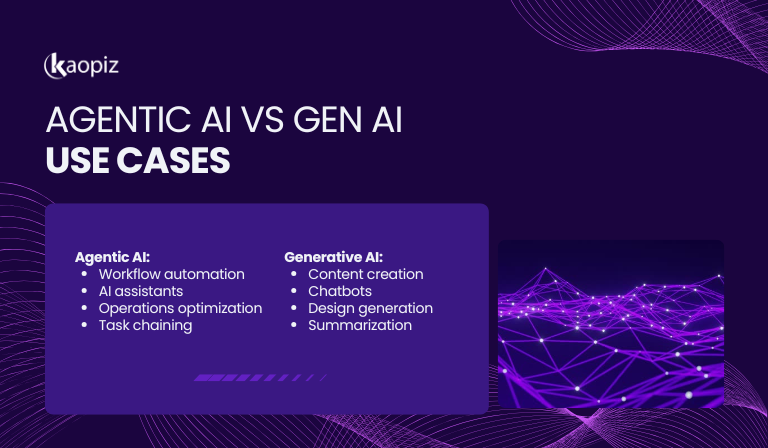
On the other hand, gen AI shines in creative and content-driven applications. Businesses use it for marketing copywriting, image or video generation, code suggestions, report drafting, and chatbots that respond to user queries. It’s best suited for generating individual outputs rather than managing entire processes.
Strengths
Another notable difference between generative AI vs agentic AI is their strengths. Agentic AI is known for its high autonomy, ability to adapt dynamically to real-world inputs, and execute end-to-end tasks with minimal human oversight. It excels in complex environments where decisions, planning, and action must be continuous and context-aware—ideal for automating business processes and intelligent operations.
Generative AI stands out for its creativity, content scalability, and speed in producing high-quality outputs like text, visuals, or code. It enhances human productivity by rapidly generating content for marketing, design, education, and more, helping teams work faster and innovate more freely.
Limitations
Agentic AI can be complex to implement, requiring sophisticated system orchestration, continuous monitoring, and well-defined guardrails. Its autonomous nature also raises ethical and accountability concerns, particularly in high-stakes or regulated environments where decision-making must be transparent and explainable.
Generative AI, while fast and creative, is limited to one-step content generation and lacks the ability to take real-world actions. It also heavily depends on the quality of its training data, which can lead to biased, inaccurate, or irrelevant outputs if not properly curated or validated.
Real-World Use Cases in Singapore: Who’s Using What?
Now that we’ve explored the key differences, let’s take a look at some generative AI vs agentic AI examples to better understand the real-world AI use cases in business.
Widely used in marketing and customer service, generative AI in Singapore helps businesses create content at scale and offer responsive support:
- Marketing & CRM: Over half of Singaporean marketers use gen AI to generate social media captions, email campaigns, and ads, boosting engagement and speed.
- Customer Support: Generative chatbots handle 60–80% of routine questions in multilingual Singapore contexts (English, Mandarin, Malay, Tamil), offering 24/7 instant support.
Considering agentic AI use cases in Singapore, it is gaining momentum in industries that demand full-cycle task automation and autonomous decision-making.
- HR Onboarding: Singapore firms use agentic AI agents to manage employee onboarding—from document collection to training workflows—streamlining HR operations.
- Insurance & Claims Processing: Automated systems handle multi-step claim processing—from verification to payout—reducing manual intervention and speeding up resolution.
- Fintech & Logistics: Financial institutions deploy agents to manage transaction monitoring and compliance. Logistics firms optimize supply chains by autonomously rerouting deliveries and managing inventories in real time.
Each AI approach serves distinct real-world use cases: Gen AI excels at content generation and human-augmented tasks, while agentic AI takes a step further by automating end-to-end workflows and decisions.
Each AI approach serves distinct real-world use cases: Gen AI excels at content generation and human-augmented tasks, while agentic AI takes a step further by automating end-to-end workflows and decisions.
How to Choose the Right AI Approach for Your Business
Choosing between agentic AI vs generative AI depends on your specific business goals, operational needs, and level of AI maturity. Here’s how to make an informed decision:
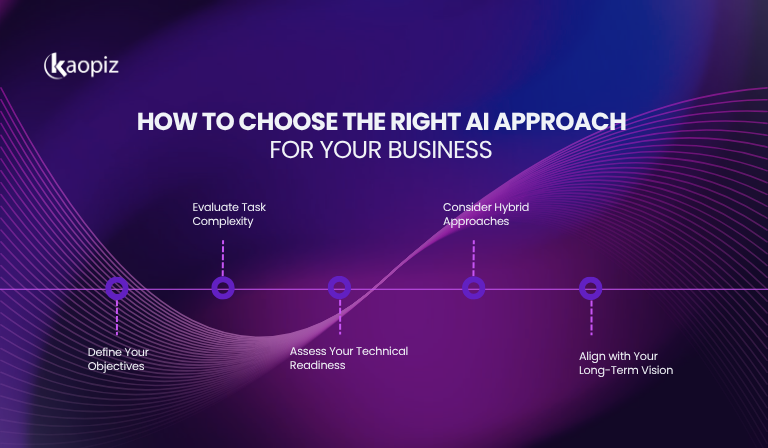
Define Your Objectives
- Use Generative AI if your main goal is to automate content creation, improve customer interaction, or enhance creative output (e.g., marketing, support, reporting).
- Use Agentic AI if you want to automate multi-step workflows, decision-making processes, or goal-oriented tasks (e.g., claim processing, onboarding, workflow orchestration).
Evaluate Task Complexity
- Generative AI is ideal for one-off tasks that require creative generation or synthesis.
- Agentic AI is designed for complex, ongoing processes that involve planning, adapting, and executing actions over time.
Assess Your Technical Readiness
- Generative AI tools are generally easier to deploy and integrate.
- Agentic AI requires stronger infrastructure, data integration, and sometimes a higher level of customization and monitoring.
Consider Hybrid Approaches
In many cases, combining both can deliver the best results. For example, a generative AI chatbot can collect user data, while an agentic AI system acts on that data to complete tasks autonomously.
Align with Your Long-Term Vision
If your organization is aiming for digital transformation and long-term automation, agentic AI offers greater scalability and autonomy. For short-term productivity gains, generative AI may be a better starting point.
By understanding your needs and capabilities, you can choose the approach that not only solves your immediate problems but also scales your future ambitions.
Why Kaopiz Is a Trusted AI Development Partner in Singapore
As AI adoption accelerates across Singapore, businesses need a partner that not only understands the technology but also knows how to implement it effectively in real-world scenarios. Kaopiz brings deep expertise in AI development, both generative AI and agentic AI, tailored to the unique demands of Singapore’s business environment.
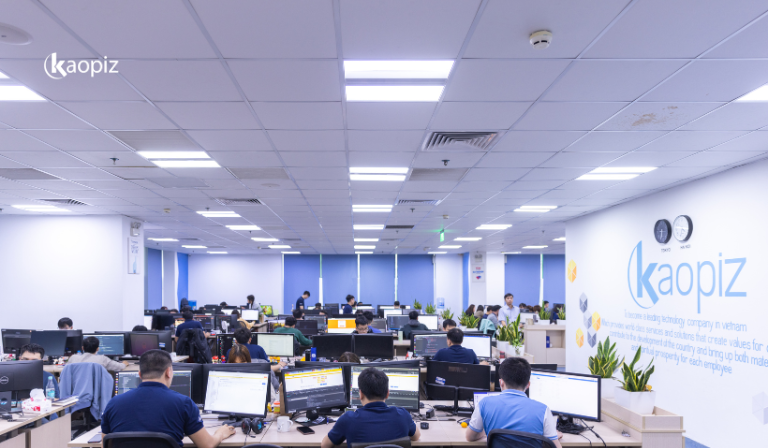
What makes Kaopiz a standout AI development partner:
- Proven Track Record: Kaopiz has delivered 500+ projects for 150+ global clients across fintech, healthcare, logistics, and more, specializing in scalable, secure, and AI-powered enterprise solutions.
- Comprehensive AI Expertise: From generative AI chatbots to agentic AI for workflow automation, our teams of AI engineers, architects, and data scientists turn ideas into robust systems.
- Deep Local Insight: We understand Singapore’s business landscape, from PDPA compliance to cultural context, ensuring AI solutions deliver impact and ROI.
- End-to-End Delivery: Kaopiz supports you through the full development cycle—from planning to launch—using agile methods tailored to your goals.
- Collaborative Approach: We co-create with your team, ensuring transparency, continuous improvement, and long-term success.
Whether you’re starting small or aiming for enterprise-wide AI transformation, Kaopiz is your reliable IT outsourcing partner for navigating the future of intelligent automation in Singapore.
Conclusion
As AI adoption accelerates across Singapore, understanding the distinction between agentic AI vs generative AI vs AI agents is critical for making the right investment. While gen AI shines in content creation and customer interaction, agentic AI excels in autonomous decision-making and end-to-end task execution.
The right choice depends on your business goals, operational complexity, and long-term vision. Whether you’re looking to boost creativity, automate workflows, or unlock new efficiencies, aligning your AI strategy with a trusted partner like Kaopiz can turn potential into performance. Ready to explore what is next? Let’s build the future—together.
FAQs
Not necessarily. Many businesses partner with experienced AI development firms like Kaopiz to handle strategy, development, and deployment, reducing the need for a full in-house team.
Yes. In fact, they complement each other well—generative AI can create content or suggestions, while agentic AI can execute decisions based on those outputs as part of a broader workflow.
Begin by identifying high-impact processes that benefit from automation. Then, consult with a trusted local AI partner like Kaopiz to plan, pilot, and scale your solution in line with PDPA and business goals.
Trending Post
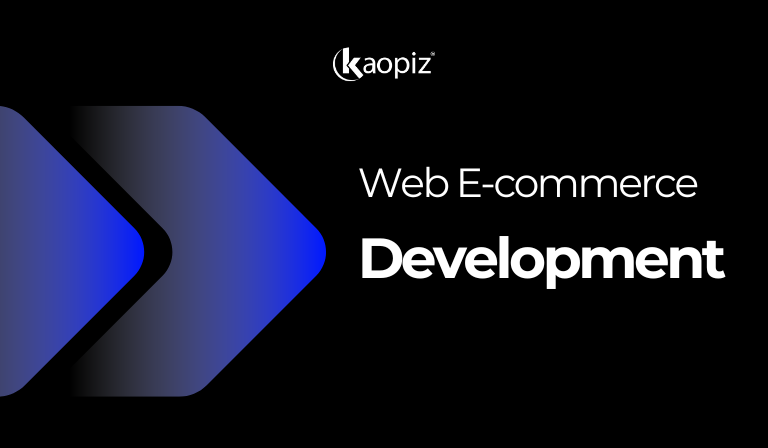

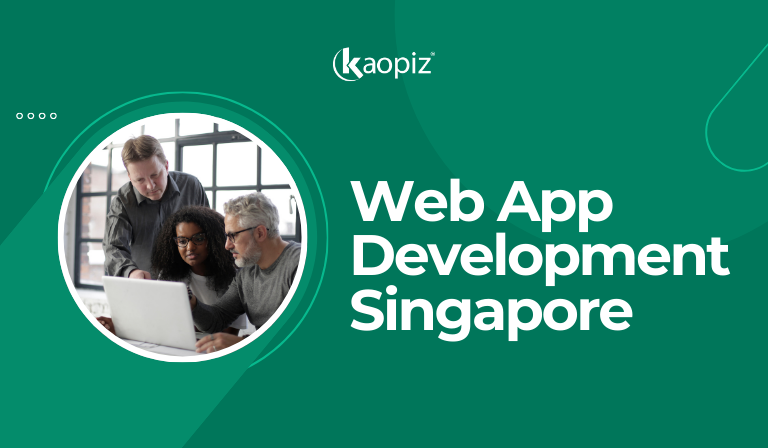
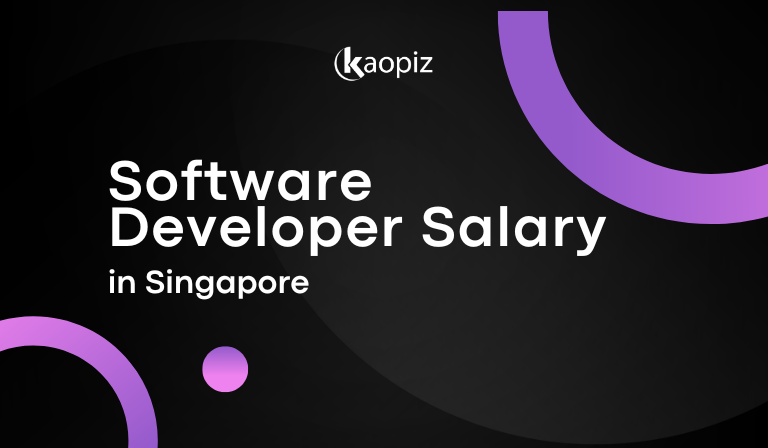
















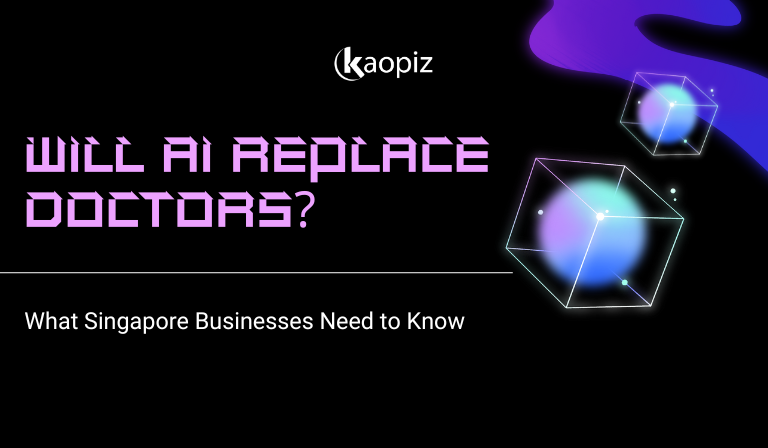
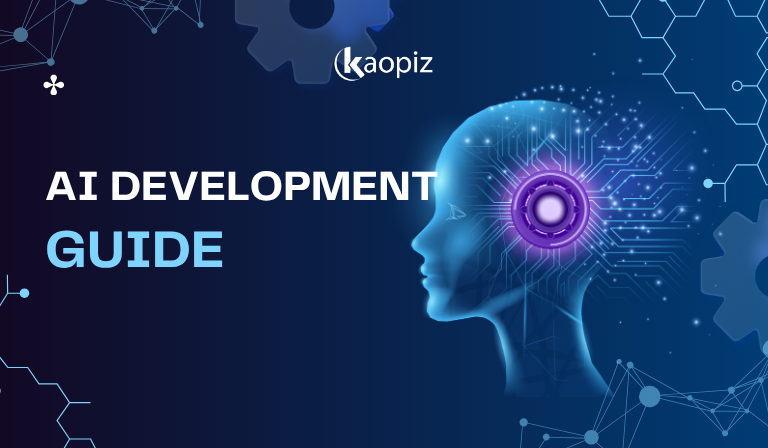
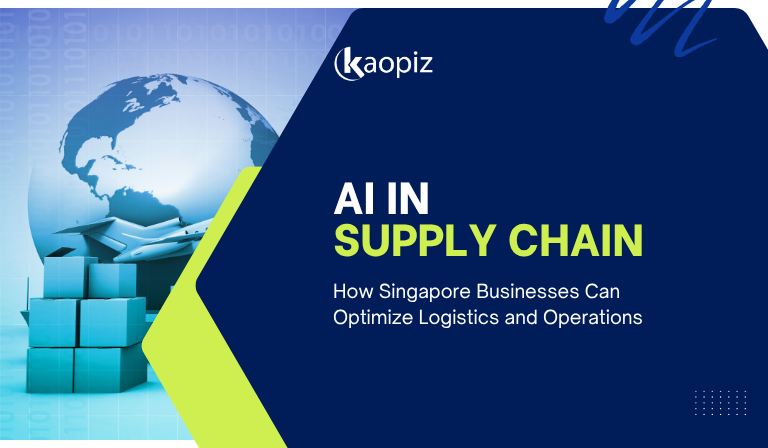

No Comments yet!